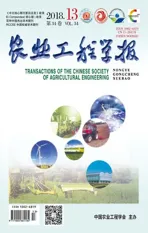北疆麦壳砂浆砌块填充蓄热材料复合墙体日光温室热性能
2018-08-10马月虹李保明张家发张耀文
马月虹,李保明,张家发,张耀文
北疆麦壳砂浆砌块填充蓄热材料复合墙体日光温室热性能
马月虹1,2,李保明1※,张家发1,张耀文2
(1. 中国农业大学水利与土木工程学院,农业农村部设施农业工程重点实验室,北京 100083;2. 新疆农业科学院农业机械化研究所,乌鲁木齐 830091)
针对新疆戈壁沙漠区日光温室在冬季严寒条件下,传统墙体在夜间难以满足作物生长对热环境需求的问题,该文研究新型的保温蓄热墙体材料和结构。将墙体主体结构采用麦壳砂浆砌块,砌块中间空格填充蓄热材料,对麦壳砂浆砌块进行配比试验和性能测试,筛选出抗压强度、导热性能较优的砌块建造温室墙体,把麦壳砂浆砌块+红砖复合墙体日光温室和37 cm砖混墙体日光温室进行热性能对比试验,并种植番茄验证。试验结果表明:在相同外界环境下,室外最低温-20.8 ℃时,麦壳砂浆砌块复合墙体日光温室内温度为7.5 ℃,而砖混墙体日光温室内温度为3.2 ℃,砌块复合墙体日光温室内夜间出现最低室温时间较砖混墙体日光温室延迟42 min;相同条件下砌块复合墙体日光温室栽培的番茄收获期早16 d,单棚产量高18.4%,验证了砌块复合墙体日光温室的保温蓄热性能优于砖混墙体日光温室,且满足果蔬生长对热环境需求。该文提出的适应戈壁沙漠区日光温室麦壳砂浆砌块复合墙体及构造条件,为新型复合墙体在日光温室中的应用研究、设计提供理论参考。
温室;墙体;温度;热性能;麦壳砂浆砌块;抗压强度;导热系数
0 引 言
近些年在新疆农业发展的大背景下,新疆的戈壁沙漠区温室产业也得到了大力发展[1]。新疆位于高纬度地区,冬季日照时间短,下午16:00时以后,热量主要从温室围护结构向外扩散,使得温室内温度急剧下降[2]。透过日光温室前屋面塑料薄膜投射到温室北墙太阳辐射深入墙体的厚度只有20~30 cm,温室墙体对太阳热能的蓄积量有限,依靠原有墙体被动式显热蓄热方式,很难满足戈壁沙漠区温室在严寒的夜晚作物生长对热环境的需求[3]。亢树华等[4]研究表明,约有50%的太阳直射辐射热能将投射到日光温室的后(北)墙体,墙体对温室的热贡献不容忽视。提高墙体的保温和蓄热性能是改善日光温室热环境的关键因素之一[5]。
国内外研究日光温室墙体材料、结构和热性能的较多。张林华等[6]研究认为砂石土材料是保温蓄热性好、经济、易得的墙体材料。但砂石土墙体易坍塌、保温性不可靠、占地面积大。国内外学者对于提高墙体蓄热性的研究多集中在加气混凝土砌块、粉煤灰砖、相变材料砖等新材料的研究[7]。张海云等[8]对泡沫混凝土在日光温室墙体中的适用性研究试验结果表明发泡混凝土浇筑温室墙体后,温室的保温性能明显高于其他同类温室。张立芸等[9]研究表明采用加气混凝土与聚苯板构筑的异质复合墙体具有比黏土红砖砌体更优越的热特性。但发泡和加气混凝土强度较低,干燥收缩值较大,墙体易吸水、开裂等。孙心心[10]对日光温室新型保温材料的制备及应用效果的研究证实了相变材料砌块的结构稳定性和蓄热性。但相变砌块出现相变材料渗漏问题,性能不可靠,且造价高。关于秸秆捆用作民用建筑保温墙体材料也有不少试验研究[11-16]。将秸秆压缩制作成型,用于墙体材料,不仅具有一定的力学强度,还具有良好的热工性能,不同密度秸秆块的导热系数为0.03~0.13w/(m·k)。秸秆块保温性能理论上远超过土壤和红砖等传统建材[17-18]。黄红英等[19]通过秸秆块墙体日光温室在苏北地区应用效果试验,与砖墙和土墙相比,秸秆块墙热传导率、体积热容和热扩散系数显著低于前两者,这种热工特性利于隔热保温但不利于蓄积热量。新疆的作物秸秆匮乏,秸秆块墙体实用性受限。蒋程瑶[20]对西北典型非耕地日光温室复合墙体砌筑方案的研究得出戈壁石复合墙体的蓄热、放热性能优于砖混墙体,炉渣空心砌块+砂石堆砌建造的温室热环境最优。由于戈壁石复合墙体夜间降温快,炉渣材料有限、造价高,堆砌砂石坍塌等,这类墙体材料也受限。
日光温室墙体研究的趋势是需要进一步研究有关墙体传热性能和墙体结构设计等关键技术问题[21]。该文对麦壳砂浆砌块+红砖,外加10 cm厚聚苯板复合墙体日光温室的蓄热保温性能进行研究,提出麦壳砂浆砌块+红砖复合结构墙体的构造条件,对砌块复合墙体温室的蓄热保温效果与砖混墙体温室进行对比试验和验证。
1 麦壳砂浆砌块制备和试验温室构建
1.1 试验时间和地点
试验时间为2016年9月-2018年2月,麦壳砂浆砌块试样制备在新疆农科院3号楼内完成,抗压强度和导热系数测试在新疆水科院水工试验大厅进行。2种不同墙体日光温室热性能对比试验和番茄栽培试验在新疆北疆伊犁地区察布查尔县良繁场新建设施农业基地进行。
1.2 试验材料
试验所用麦壳产自新疆奇台县小麦产区;水泥为C32.5普通硅酸盐水泥;细沙产自和田地区;粘合剂选用型号为CYD-128,外观透明,呈淡黄;环氧值0.5~0.54 eq/100 g;黏度11~14 Pa×s(25 ℃条件下)。试验用水来自试验大厅自来水。
1.3 试验仪器设备
试验采用天平(ACS-30,浙江君凯顺工贸公司)精确称量制作麦壳砂浆砌块的水泥、麦壳和粘合剂等各成分质量;麦壳砂浆砌块在自制振动台上充分振动后成型;用0~5 kN的万能试验机对麦壳砂浆砌块进行动力试验,测量抗压强度;“导热系数”用电导率仪(PHS-3E,上海雷磁)测量。
1.4 麦壳砂浆砌块配比影响因素确定
结合文献资料和前期试验基础,为了分析各因素对砌块性能的影响,采用正交试验来确定各种物料的合理配比。经过分析和前期试验确定了影响砌块抗压强度和导热性能的3个主要因素是:水泥用量、粘合剂掺量和碎麦壳掺量。正交试验设计为三要素三水平L9(33),试验因素及编码水平如表1所示。

表1 因素编码水平表
注:表中的掺量为质量比。
Note: The content in the table are percentages by mass.
1.5 麦壳砂浆砌块制作方法
首先清理模具,模具的外尺寸长×宽×高为370 mm×240 mm×120 mm,内设2个尺寸为110 mm×120 mm×100 mm的空格,为利于脱模,在模具内表面涂适量的机油。然后将各种物料按配比称质量,混合搅拌均匀后置于振动台上振动,使各物料充分混合,将振动混合充分的砂浆装入模具并压实,接着将装好砂浆的模具再次置于振动台振动,使物料更加均匀充分分布,振动后模具内砂浆体积变小,需要再以砂浆填满,振动均匀后抹平。放置5~10 min,标注试验砌块的编号和日期。静置12 h后拆模,拆模后对试验砌块连续养护28 d,正交试验设计的9种配比砌块,每种制作30块。麦壳砂浆砌块见图1。
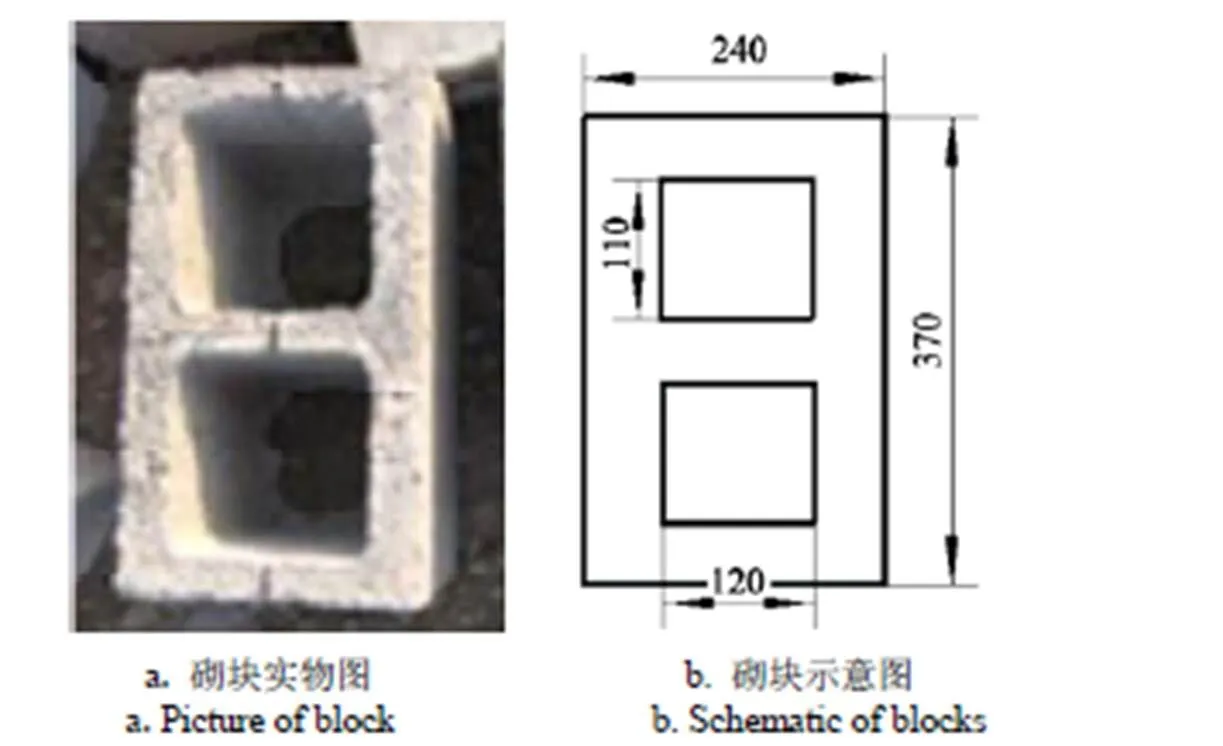
图1 麦壳砂浆砌块
1.6 麦壳砂浆砌块性能测试
密度测试:在正交试验的9种砌块试件中随机各抽取10个,分别称取质量,根据体积计算出每种砌块各自密度,每种砌块密度取10个砌块的平均值。
抗压强度测试:把已经测量过质量,密度已知的10个砌块试件用微机控制自动压力试验机进行抗压强试验,每种砌块抗压强度均取10个砌块的平均值。
导热系数测试:采用导热测定仪,对砌块的导热系数进行测定,取10个砌块的平均值。
1.7 试验温室和对照温室的选取
选取新疆北疆察布查尔县良繁场设施农业园区内2座日光温室测试。A试验日光温室设计为墙体为37 cm麦壳砂浆砌块+红砖,外加10 cm厚聚苯板,0.5~1.5 m高度处是麦壳砂浆砌块,其他高度位置是红砖,见图2a。
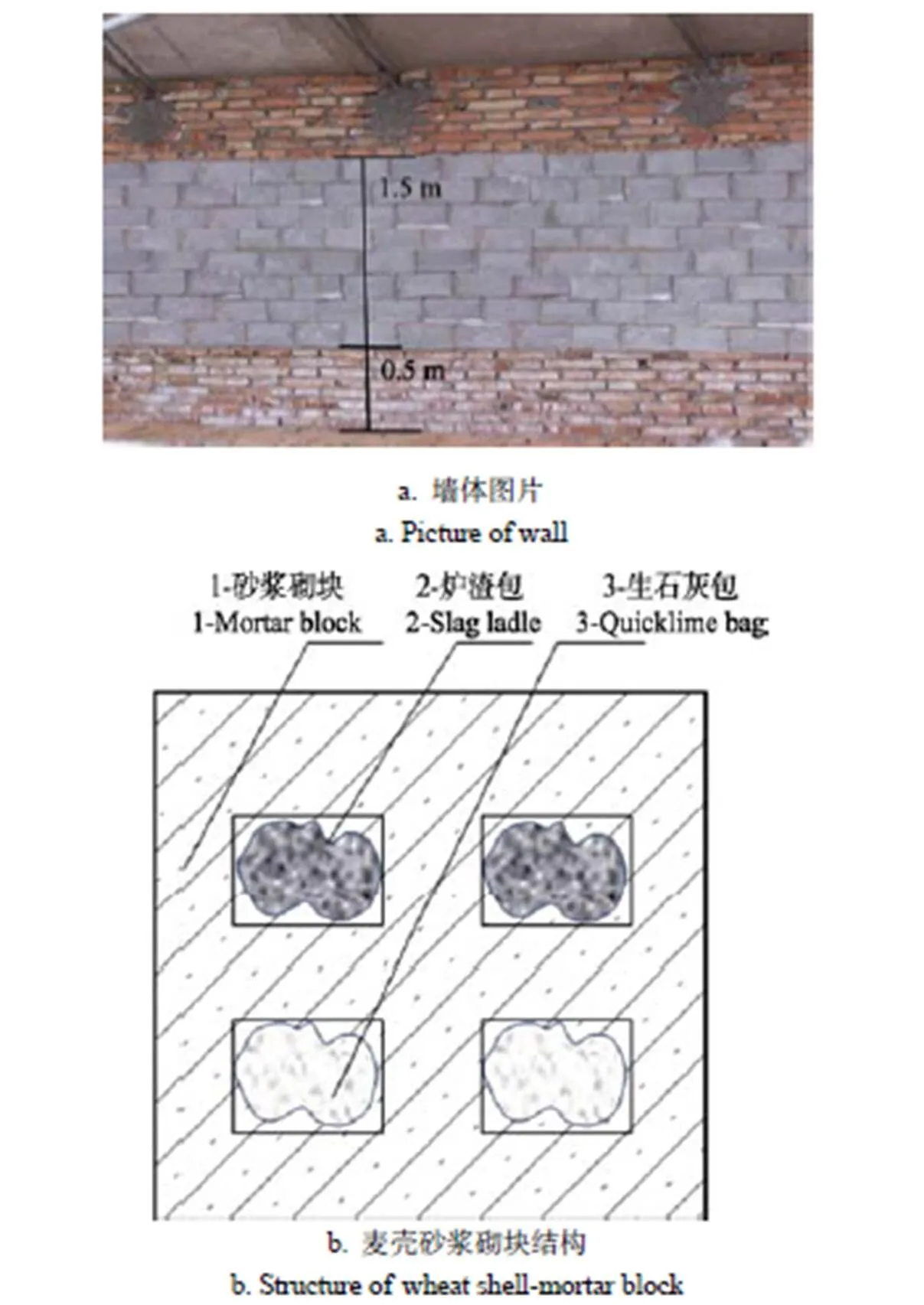
图2 麦壳砂浆砌块+红砖复合墙体(A温室)
由图2b可知,麦壳砂浆砌块为砂浆砌块内填充生石灰包(墙体内侧)和炉渣包(墙体外侧)而构成。对照温室B温室,选取了北疆地区普遍使用的日光温室,其墙体为37 cm砖墙,外加10 cm厚聚苯板。
2 日光温室热性能和生产性能测试
A试验温室和B对照温室均使用相同保温被覆盖保温,2个型号相同热风炉供暖。
2.1 两种日光温室结构参数
A温室墙体结构为37 cm厚砂浆砌块+红砖的复合墙体,外加10 cm聚苯板,B温室墙体结构为37 cm红砖+10 cm聚苯板的砖混墙体,2座日光温室的主要结构参数见表2。
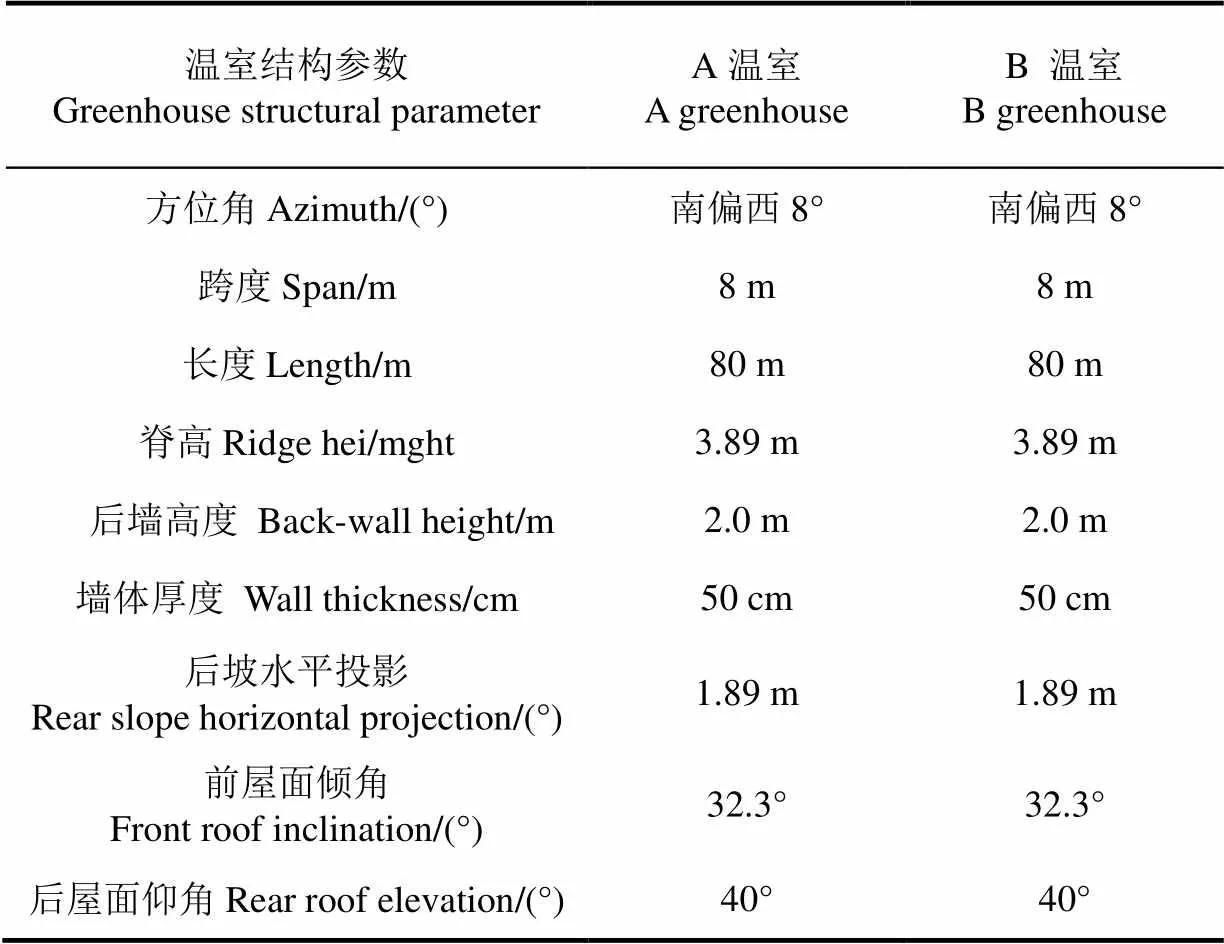
表2 日光温室的结构参数
2.2 日光温室热性能测试
试验以日光温室内的气温、地温作为测试对象。日光温室内测点平面布置按下图3布设,1、2、3测点距离前屋面1.5 m,4、5、6测点距离北墙1.5 m,1、6测点距离西墙4 m,3、4测点距离东墙4 m。在每个平面点垂直方向上设2个点,分别位于地表上方0.20 和0.60 m(植株茎叶密集区域),一共布设12个测点。室外设1个温度测点,布设在光照测点附近,距地面高度1.50 m处。地温测点也按图3布设,测点深度为地表以下0.10 m(植物根系发达区域),一共布设6个测点。温室内温度数据采用6个测点的地温和12个测点的气温的平均值。

图3 测点布置示意图
2.3 日光温室生产性能(番茄栽培)测试
A温室和B温室栽培的番茄苗木品种都是金鹏3号、穴盘育苗33 d苗龄、5片真叶、杆粗叶绿的苗木。定植前土地整理好,施用腐熟有机肥、硫酸钾、磷酸二铵和油渣。起垄栽培,70 cm +50 cm宽窄行,株距40 cm,定植株数2 274株、定植时间2017-09-10,各种植内容均相同。生长期采用相同的滴灌系统和水肥施用量,相同植株调整和花果调整管理,进行番茄栽培试验,从2017年9月定植到2018年2月成熟收获,记录定植时间、开花时间和采摘时间及总产量。
3 结果与分析
3.1 麦壳砂浆砌块配比
表3为砌块内不同水泥掺量、碎麦壳掺量和粘合剂掺量砌块抗压强度和导热系数的结果,根据表3因素水平,三要素三水平L9(33)正交试验结果可知,各因素对抗压强度和导热系数均有作用和影响。
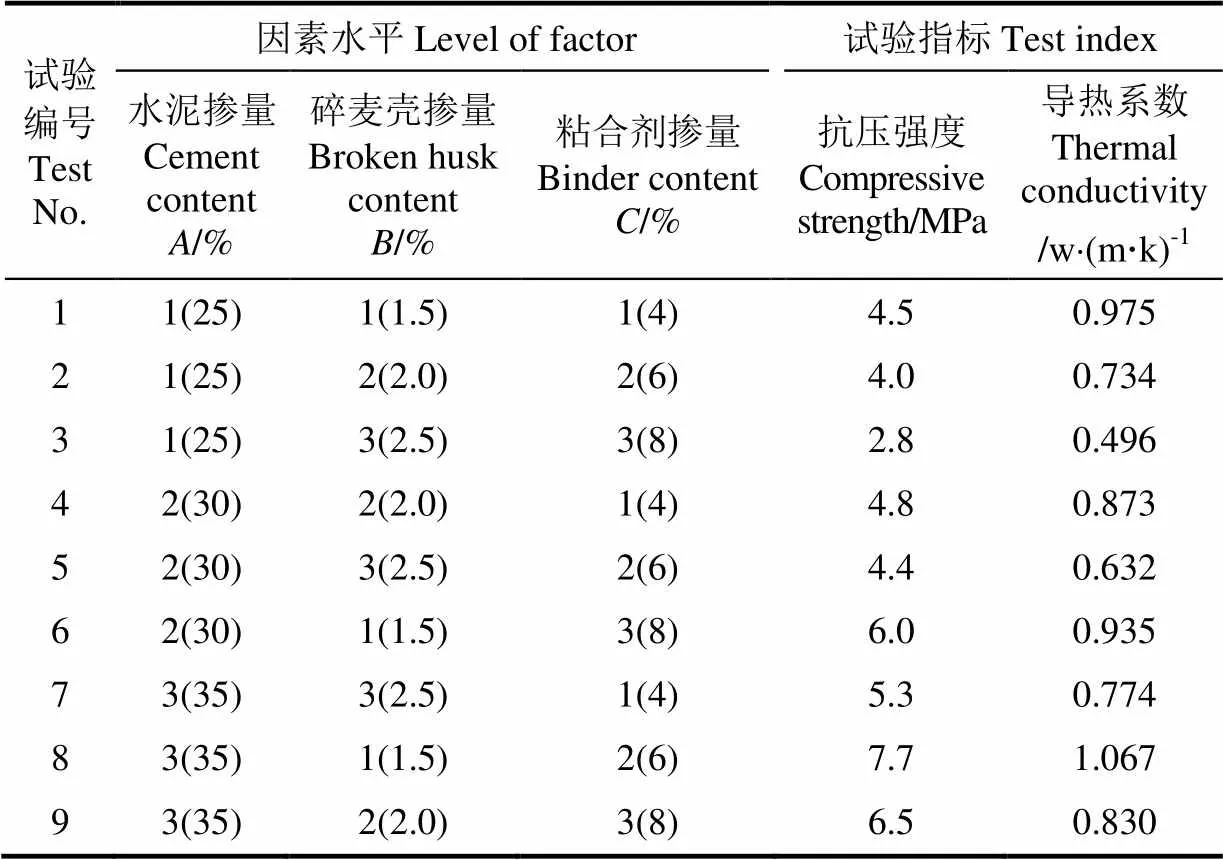
表3 试验设计方案及结果
抗压强度和导热系数是砌块性能的主要考核指标,在满足墙体抗压强度的承重前提下,导热系数越小,其保温性能越好,散热速率越稳定。同行学者研究表明:墙体厚度为37 cm时,参考文献[22]、[23]中砌块的抗压强度3.5 MPa和4.6 MPa,温室墙体强度均满足承重要求,导热系数0.811 W/(m×k)和0.792 W/(m×k),墙体导热性都满足温室栽培要求[22-23,9]。
从表3可以看出,试验编号4、6、7、8、9砌块的抗压强度都≥4.8 MP,试验编号2、3、5、7砌块的导热系数均≤0.774 w/(m×k),只有试验编号7砌块的抗压强度和导热系数2个条件均满足,即抗压强度好,保温性能也好。根据正交试验结果和以上分析,综合考虑麦壳砌块的抗压强度和导热系数,最终确定选用试验编号7的砌块建设墙体,该砌块的抗压强度优于同行研究的砌块,导热系数好于同行研究的砌块,用于日光温室墙体可行。砌块合理配比为水泥35%,粘合剂4%,麦壳2.5%,细砂、水适量。性能试验采用该麦壳砂浆砌块填充炉渣、生石灰+红砖用作A日光温室墙体建造材料。
3.2 日光温室热性能测试结果
选取试验数据2016年冬季到2017年春季最冷的8 d(2017-01-14~2017-01-21)作为比较分析对象,日光温室热性能测试结果如表4。表4中时间均为新疆时间。

表4 日光温室热性能测试结果
由表4可知,相同结构参数的日光温室,使用同样保温被和热风炉,夜间新疆时间03:15室外温度–12.8 ℃时,A温室室温为9.5 ℃,而B温室室温为4.4 ℃, A温室比B温室室温高5.1 ℃。在出现冬季夜间极限最低温–20.8 ℃时,A温室能保证室温达到7.5 ℃,而B温室室温为3.2 ℃,A温室比B温室室温高4.3 ℃。并且A温室出现最低室温时间较B温室延迟42 min,这进一步说明A温室热性能明显优于B温室,其蓄热、保温性能更佳。麦壳砂浆砌块替代土壤、红砖等常规建材构建日光温室保温墙体具有可行性。
3.3 日光温室生产性能(番茄栽培)测试结果
番茄生育适宜温度范围为10~33 ℃。开花结果的适宜温度白天为20~30 ℃,夜间为15~20 ℃。在15 ℃以下不能开花,10 ℃时生长停止,–1 ℃时植株受冻而死亡。番茄是喜光作物,光饱和点为7×104lx,光补偿点2000 lx。温度高低能影响番茄果实颜色的深浅,尤其是番茄红素含量的高低,低温不利于番茄红素的合成,番茄红素以20 ~24 ℃之间宜生成;光可诱导番茄幼苗累积类胡萝卜素,红光能极大的促进番茄红素的合成[24]。A、B温室番茄的栽培品种和种植管理一样,A温室和B温室内栽培的番茄开花时间分别为2017-10-08和2017-10-15,A温室内番茄开花时间早7 d。A、B温室内番茄成熟收获时间分别为2017-12-07和2018-01-02,A温室内番茄收获早16 d。取首月温室番茄产量,A、B温室单棚产量分别为1 768和1 493 kg,A温室较B温室单棚产量高18.4%。说明A温室能够蓄积更多的热能,适合果蔬生长的干物质积累,使作物收获期提早、产量增加。A温室散热速率稳定,从而番茄果实形状较均匀。温室内温度和光照对番茄的产量和果实外形有着至关重要的影响。
该墙体温室在北疆察县已建成生产2 a,经历了风雪和生产考验,墙体未出现坍塌和垮裂等问题,也验证了该砌块满足用做日光温室墙体材料的抗压和承重要求。
4 结 论
该文采用麦壳砂浆砌块代替普通红砖建设砂浆砌块+红砖复合墙体试验温室(A温室),与砖混墙体温室(B温室)对比,结合温室内温度和番茄栽培产量测试结果,研究了麦壳砂浆砌块复合墙体日光温室的热性能和生产性能,得出结论如下:
1)麦壳砂浆砌块采取合理配比:水泥35%,粘合剂4%,麦壳2.5%,砌块抗压强度为5.3 MPa,导热系数为0.774 W/(m×k),满足用作日光温室墙体的承重和热性能要求,能够代替传统的红砖建设日光温室墙体。有利于节约土地资源、实现沙土和麦壳秸秆的综合利用,是戈壁沙漠区日光温室墙体材料的新探索。
2)冬季极限最低温–20.8 ℃时,A温室较B温室夜间室温提高4.3 ℃,出现最低室温时间延迟42 min,A温室热性能优于B温室,能够蓄积更多的热能且散热速率稳定。
3)A温室较B温室栽培的番茄收获期早16 d,单棚产量高18.4%。该砌块复合墙体可以有效改善日光温室内作物生长环境,能满足喜温、喜光果菜生长,且适合果蔬生长的干物质积累,从而使果蔬收获提前、产量增加、果实外形均匀。且该砌块墙体温室经历住了风雪载荷和生产考验。
该试验没有进一步分析该砂浆砌块复合墙体蓄积的热量,今后在研究中将着重研究复合结构墙体蓄热,从而进一步揭示墙体蓄热与作物产量间的关系。
[1] 王浩,宋羽,王强. 新疆戈壁设施少土栽培技术初探[J].中国园艺文摘,2011,27(11):133-134.
[2] 王伟,张京社,王引斌. 我国日光温室墙体结构及性能研究进展[J]. 山西农业科学,2015,43(4):496-498. Wang Wei, Zhang Jingshe, Wag Yinbin. The research progress on structure properties of solar greenhouse walls in China[J]. Journal of Shanxi Agricultural University, 2015, 43(4): 496-498. (in Chinese with English abstract)
[3] 李嘉怡,秦红,马彩雯. 新疆戈壁环境下日光温室保温被保温性能研究[J]. 新疆农业科学,2015,52(5):931-939. Li Jia yi, Qin Hong, Ma Caiwen. et al. Requirements of greenhouse heat preservation quiit in gobi desert in Xinjiang[J]. Xinjiang Agricultural Sciences, 2015, 52(5): 931-939. (in Chinese with English abstract)
[4] 亢树华,房思强,戴雅东. 节能型日光温室墙体材料及结构的研究[J].中国蔬菜,1992(6):1-5.
[5] Chen Wei, Liu Wei. Numerical and experimental analysis of convection heat transfer in passive solar heating room with greenhouseand heat storage[J]. Solar Energy, 2004, 76(2004): 623-633.
[6] 张林华,董瑞,曲云霞,等. 沙漠边缘地区日光温室墙体蓄热性能研究[J]. 山东暖通空调,2007,(2):557-560. Zhang Linhua, Dong Rui, Qu Yunxia, et al. Study on heat storage performance of heliogreenhouse wall in the edge of desert[J], Shandong HVAC, 2007(2): 557-560. (in Chinese with English abstract)
[7] 杨建军.西北地区日光温室土质墙体厚度优化及其保温性研究[D]杨凌:西北农林科技大学,2009.
Yang Jianjun. Study on The Thickness Optimization and Thermal Insulation of The Soil Wall in The Greenhouse in Northwest China[D]. Yangling: Northwest Agriculture and Forestry University, 2009.
[8] 张海云,肖棠,吴海峰. 泡沫混凝土在日光温室墙体中的适用性研究[J]. 安徽农业科学,2014,42(19):6446-6447. Zhang Haiyun, Xiao Tang, Wu Haifeng. Study on the applicability of foam concrete in the wall of heliogreenhouse[J].Journal of Anhui Agricultural Sciences, 2014, 42(19): 6446-6447. (in Chinese with English abstract)
[9] 张立芸,徐刚毅,马承伟,等.日光温室新型墙体结构性能分析[J].沈阳农业大学学报,2006,37(3):459-462. Zhang Liyun, Xu Gangyi, Ma Chengwei, et al. Analysis on performance of new wall structure in heliogreenhouse[J]. Journal of Shenyang Aricultural University, 2006, 37(3): 459-462. (in Chinese with English abstract)
[10] 孙心心. 日光温室新型保温材料的制备及应用效果的研究[D]. 杨凌:西北农林科技大学,2010.Sun Xinxin. Study on The Preparation and Effect on Application of New Thermal Insulation Materials in Greenhouse[D]. Yangling: Northwest Agriculture and Forestry University, 2010. (in Chinese with English abstract)
[11] 傅志前. 不同密度的麦秸秆块墙导热系数试验研究[J]. 建筑材料学报,2012,15(2):289-292. Fu Zhiqian. Experimental study on thermal conductivity of barley walls with different density[J]. Journal of Architectural Materials, 2012, 15(2): 289-292. (in Chinese with English abstract)
[12] 刘婷婷,余自若,杨雷. 秸秆建筑[M]. 北京:中国建筑工业出版社,2007.
[13] 吴朗,况青梅. 稻草砌块砖建造草砖房的结构工艺探讨[J].安徽农业科学,2007,35(16):5009-5012. Wu Lang, Kuang Qing mei, et al. Discussion on construction technology of straw brick building with straw brick blocks[J]. Journal of Anhui Agricultural Sciences, 2007, 35(16): 5009-5012. (in Chinese with English abstract)
[14] Taha A, Adel B, Wei Wu. Compressive strength of fiber reinforced earth plasters for straw bale buildings[J]. Australian Journal of Agriculture Engineering, 2010, 3(1): 86-91.
[15] Pragyan B, Dharma R D, Keshab Ne, et al. Straw bale in construction of building and its future in India[J]. International Journal of Modern Engineering Research, 2012, 2(2): 422-426.
[16] Jim C, Pieter D W, John L W, et al. Development of a cost effective probe for the long term monitoring of straw bale buildings[J]. Building and Environment, 2011, 46(1): 156-164.
[17] 谭季秋,刘军安,朱培立,等. 稻草秸秆压缩研究及制粒机械设计[J]. 湖南工程学院学报,2012, 22(1): 30-33. Tan Jiqiu, Liu Junan, Zhu Peili, et al. Study on the compression of straw straw and the design of granulating machine[J]. Journal of Hunan Institute of Engineering, 2012, 22(1): 30-33. (in Chinese with English abstract)
[18] 陈端生. 中国节能型日光温室建筑与环境研究进展[J]. 农业工程学报,1994,10(1):123-129. Chen Duansheng. Research progress on building and environment of energy saving heliogreenhouse in China[J]. Transactions of the Chinese Society of Agricultural Engineering (Transactions of the CSAE), 1994,10(1): 123-129. (in Chinese with English abstract)
[19] 黄红英,武国峰,孙恩慧,等. 秸秆块墙体日光温室在苏北地区应用效果试验[J]. 农业工程学报,2014,30(14):170-178. Huang Hongying, Wu Guofeng, Sun Enhui, et al. Effect of straw block wall application on heliogreenhouse in North Jiangsu[J]. Transactions of the Chinese Society of Agricultural Engineering (Transactions of the CSAE), 2014, 30(14): 170-178. (in Chinese with English abstract)
[20] 蒋程瑶. 西北典型非耕地日光温室复合墙体砌筑方案的研究[D]. 北京:中国农业大学,2013. Jiang Chengyao. Research on Composite Wall Masonry Scheme of Typical Uncultivated Area Heliogreenhouse in Northwest China[D]. Beijing: China Agricultural University, 2013. (in Chinese with English abstract)
[21] 张勇.西北日光温室传热学简化模型构建及温光高效新结构初探[D].杨凌:西北农林科技大学,2012.
Zhang Yong. Construction of a Simplified Heat Transfer Model and First Exploration on Highly Efficient Coupling Temperature and Light in The Northwest Greenhouse[D]. Yangling: Northwest Agriculture and Forestry University, 2012. (in Chinese with English abstract)
[22] 张立芸.新材料墙体日光温室的试验研究[D]. 北京:中国农业大学,2006. Zhang Liyun,Experimental Study on New Material Wall Solar Greenhouse [D]. Beijing: China Agricultural University, 2006. (in Chinese with English abstract)
[23] 王宏丽,李晓野,邹志荣.相变蓄热砌块墙体在日光温室中的应用效果[J]. 农业工程学报,2011,27(5):253-258. Wang Hongli, Li xiaoye, Zou zhirong. Application of brick wall with phase change rice husk in solar greenhouse[J]. Transactions of the Chinese Society of Agricultural Engineering (Transactions of the CSAE), 2011, 27(5): 253-258. (in Chinese with English abstract)
[24] 孟凡娟,王富.番茄果实内番茄红素的合成及影响因素[J]. 北方园艺,2001,5:15-17.
Thermal performance of solar greenhouse with composite wall using wheat shell-mortar block filling with heat storage material in north Xinjiang
Ma Yuehong1,2, Li Baoming1※, Zhang Jiafa1, Zhang Yaowen2
(1.100083; 2.830091)
The greenhouse in the Gobi Desert region of Xinjiang is under severe conditions in winter. The problem is that the traditional wall can not meet the demand of thermal environment for crop growth at night. The main structure of the wall is made of wheat shell and mortar block. The main factors affecting the compressive strength and thermal conductivity of the block are cement content, binder content and wheat shell content. Three-element and three-level orthogonal test is designed to determine the ratio of wheat shell to mortar block. Finally, it is determined that the reasonable level is 35% cement, 4% adhesive, 2.5% wheat shell, fine sand and moderate amount of water. The wheat shell-mortar block sample was prepared and the tests of compressive strength and thermal conductivity were carried out. Solar greenhouse was built with composite wall of wheat shell-mortar block and filling material. A solar greenhouse was 37 cm ordinary brick wall together with 10 cm benzene panel. Each greenhouse has 24 measuring points, and the mean temperature and ground temperature were measured. The thermal insulation and heat storage performance of 2 kinds of solar greenhouses with different walls at winter night were compared, and the middle space of the block was filled with slag and quicklime which both have small thermal conductivity and are stable. The data in the coldest 8 days from January 14 to January 21, 2017 were selected as the comparative study object. The results show that: In the same external environment, when the minimum temperature at winter night is-12.8 ℃, the indoor temperature of wheat shell-mortar block composite wall is 9.5 ℃, while the temperature of brick wall in solar greenhouse is 4.4 ℃. The temperature of the greenhouse of compound wall is 5.1 ℃ higher than that of brick wall. When the temperature at winter night is –20.8 ℃, the indoor temperature of wheat shell-mortar block composite wall is 7.5 ℃, while the temperature of brick wall in solar greenhouse is 3.2 ℃. The temperature of the greenhouse of compound wall is 4.3 ℃ higher than that of brick wall. The minimum room temperature at night in the solar greenhouse of masonry compound wall occurs 42 min later than normal brick masonry wall. For the tomato planted under the same conditions in 2 kinds of wall greenhouses, the flowering time of tomato in compound wall greenhouse is 7 d earlier, and the harvest time of tomato was 16 d earlier. The tomato yield during the first month in composite wall solar greenhouse is 1 768 kg, and the yield in brick wall solar greenhouse is 1 493 kg. The yield of single shed in composite wall solar greenhouse is increased by 18.4%. It is verified that the thermal insulation and heat storage performance of the composite wall solar greenhouse with wheat shell-mortar block and filling material are obviously superior to brick wall solar greenhouse. It can accumulate more heat energy and the rate of heat dissipation is stable. The compound wall solar greenhouse can effectively improve the growing environment of crops in the greenhouse, which meets the growth requirement of the fruits and vegetables for good temperature and good light. And it is suitable for the accumulation of dry matter in fruits and vegetables, so crops can be harvested in advance and production increases. The research provides a theoretical reference for the design and application of mortar block composite wall in solar greenhouse
greenhouse; walls; temperature; thermal performance; wheat shell-mortar block;compressive strength; thermal conductivity
马月虹,李保明,张家发,张耀文. 北疆麦壳砂浆砌块填充蓄热材料复合墙体日光温室热性能[J]. 农业工程学报,2018,34(13):233-238. doi:10.11975/j.issn.1002-6819.2018.13.028 http://www.tcsae.org
Ma Yuehong, Li Baoming, Zhang Jiafa, Zhang Yaowen. Thermal performance of solar greenhouse with composite wall using wheat shell-mortar block filling with heat storage material in north Xinjiang[J]. Transactions of the Chinese Society of Agricultural Engineering (Transactions of the CSAE), 2018, 34(13): 233-238. (in Chinese with English abstract) doi:10.11975/j.issn.1002-6819.2018.13.028 http://www.tcsae.org
2017-11-20
2018-04-20
国家自然科学基金资助项目(51768072)
马月虹,研究员,博士生,硕士生导师,主要从事设施农业工程研究。Email:923999218@qq.com。
李保明,教授,博士,博士生导师,主要从事设施农业工程工艺与环境研究。Email:libm @cau.edu.cn。
10.11975/j.issn.1002-6819.2018.13.028
S625
A
1002-6819(2018)-13-0233-06
